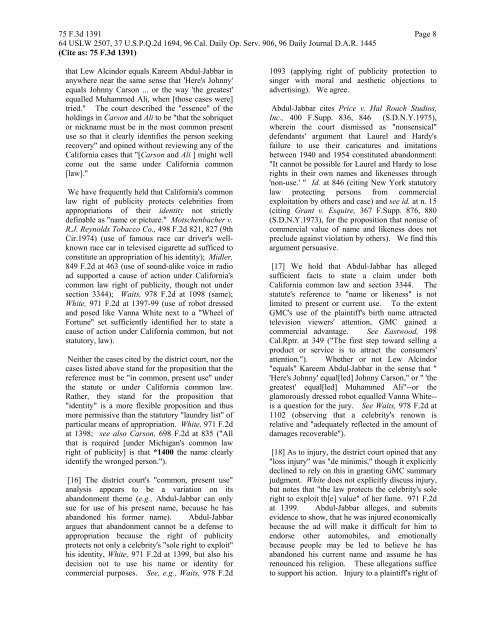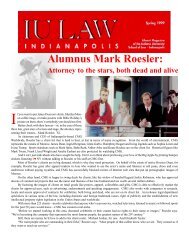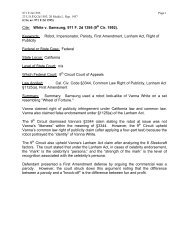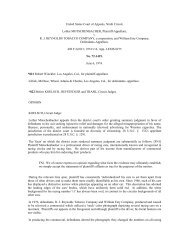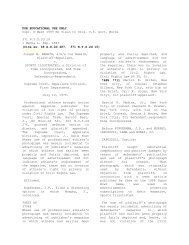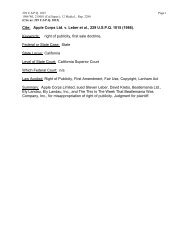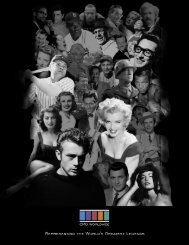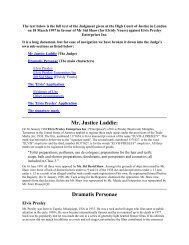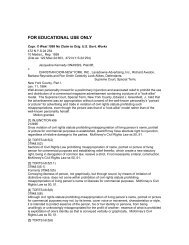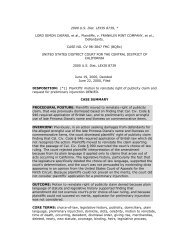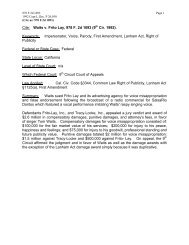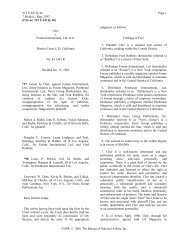Abdul Jabbar v. General Motors - Mark Roesler
Abdul Jabbar v. General Motors - Mark Roesler
Abdul Jabbar v. General Motors - Mark Roesler
- No tags were found...
Create successful ePaper yourself
Turn your PDF publications into a flip-book with our unique Google optimized e-Paper software.
75 F.3d 1391 Page 864 USLW 2507, 37 U.S.P.Q.2d 1694, 96 Cal. Daily Op. Serv. 906, 96 Daily Journal D.A.R. 1445(Cite as: 75 F.3d 1391)that Lew Alcindor equals Kareem <strong>Abdul</strong>-<strong>Jabbar</strong> inanywhere near the same sense that 'Here's Johnny'equals Johnny Carson ... or the way 'the greatest'equalled Muhammed Ali, when [those cases were]tried." The court described the "essence" of theholdings in Carson and Ali to be "that the sobriquetor nickname must be in the most common presentuse so that it clearly identifies the person seekingrecovery" and opined without reviewing any of theCalifornia cases that "[Carson and Ali ] might wellcome out the same under California common[law]."We have frequently held that California's commonlaw right of publicity protects celebrities fromappropriations of their identity not strictlydefinable as "name or picture." Motschenbacher v.R.J. Reynolds Tobacco Co., 498 F.2d 821, 827 (9thCir.1974) (use of famous race car driver's wellknownrace car in televised cigarette ad sufficed toconstitute an appropriation of his identity); Midler,849 F.2d at 463 (use of sound-alike voice in radioad supported a cause of action under California'scommon law right of publicity, though not undersection 3344); Waits, 978 F.2d at 1098 (same);White, 971 F.2d at 1397-99 (use of robot dressedand posed like Vanna White next to a "Wheel ofFortune" set sufficiently identified her to state acause of action under California common, but notstatutory, law).Neither the cases cited by the district court, nor thecases listed above stand for the proposition that thereference must be "in common, present use" underthe statute or under California common law.Rather, they stand for the proposition that"identity" is a more flexible proposition and thusmore permissive than the statutory "laundry list" ofparticular means of appropriation. White, 971 F.2dat 1398; see also Carson, 698 F.2d at 835 ("Allthat is required [under Michigan's common lawright of publicity] is that *1400 the name clearlyidentify the wronged person.").[16] The district court's "common, present use"analysis appears to be a variation on itsabandonment theme (e.g., <strong>Abdul</strong>-<strong>Jabbar</strong> can onlysue for use of his present name, because he hasabandoned his former name). <strong>Abdul</strong>-<strong>Jabbar</strong>argues that abandonment cannot be a defense toappropriation because the right of publicityprotects not only a celebrity's "sole right to exploit"his identity, White, 971 F.2d at 1399, but also hisdecision not to use his name or identity forcommercial purposes. See, e.g., Waits, 978 F.2d1093 (applying right of publicity protection tosinger with moral and aesthetic objections toadvertising). We agree.<strong>Abdul</strong>-<strong>Jabbar</strong> cites Price v. Hal Roach Studios,Inc., 400 F.Supp. 836, 846 (S.D.N.Y.1975),wherein the court dismissed as "nonsensical"defendants' argument that Laurel and Hardy'sfailure to use their caricatures and imitationsbetween 1940 and 1954 constituted abandonment:"It cannot be possible for Laurel and Hardy to loserights in their own names and likenesses through'non-use.' " Id. at 846 (citing New York statutorylaw protecting persons from commercialexploitation by others and case) and see id. at n. 15(citing Grant v. Esquire, 367 F.Supp. 876, 880(S.D.N.Y.1973), for the proposition that nonuse ofcommercial value of name and likeness does notpreclude against violation by others). We find thisargument persuasive.[17] We hold that <strong>Abdul</strong>-<strong>Jabbar</strong> has allegedsufficient facts to state a claim under bothCalifornia common law and section 3344. Thestatute's reference to "name or likeness" is notlimited to present or current use. To the extentGMC's use of the plaintiff's birth name attractedtelevision viewers' attention, GMC gained acommercial advantage. See Eastwood, 198Cal.Rptr. at 349 ("The first step toward selling aproduct or service is to attract the consumers'attention."). Whether or not Lew Alcindor"equals" Kareem <strong>Abdul</strong>-<strong>Jabbar</strong> in the sense that "'Here's Johnny' equal[led] Johnny Carson," or " 'thegreatest' equal[led] Muhammed Ali"--or theglamorously dressed robot equalled Vanna White--is a question for the jury. See Waits, 978 F.2d at1102 (observing that a celebrity's renown isrelative and "adequately reflected in the amount ofdamages recoverable").[18] As to injury, the district court opined that any"loss injury" was "de minimis," though it explicitlydeclined to rely on this in granting GMC summaryjudgment. White does not explicitly discuss injury,but notes that "the law protects the celebrity's soleright to exploit th[e] value" of her fame. 971 F.2dat 1399. <strong>Abdul</strong>-<strong>Jabbar</strong> alleges, and submitsevidence to show, that he was injured economicallybecause the ad will make it difficult for him toendorse other automobiles, and emotionallybecause people may be led to believe he hasabandoned his current name and assume he hasrenounced his religion. These allegations sufficeto support his action. Injury to a plaintiff's right of


